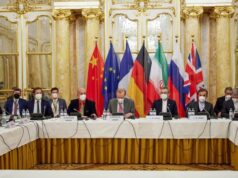China’s Renaming Spree in Arunachal Pradesh: Narrative Built on Perfidy
“The most perfidious way of harming a cause consists of defending it deliberately with faulty arguments”—Friedrich Nietzsche

By Colonel Satish Singh Lalotra
A narrative can be quantified in terms of a story or view point that a nation state wants to put forward on the basis of how it wants the world at large to perceive a given situation. The war of narratives unfortunately has gained traction in the 21st century due to the relative ease of its spread riding high on the crest of social media interactions that evinces an equal faster response from the public at large. The methodology applied by most of the countries ranges from influencing newspapers, yellow journalism to the vast array of gadgets and apps that are available at the click of a mouse on the internet highway. Who can forget the irresistible propaganda minister of Adolf Hitler, the one of its only kind –‘Joseph Goebbels’ who by his cantankerous speeches in favour of anti-Semitism during the 2WW was singly responsible for turning the tide against the Jews and in turn mass murders of the same?
The importance of narrative building cannot be down played because of its potential aid in Geo-politics. The power of narrative building has helped many countries in achieving their national aim which otherwise they wouldn’t have been able to even touch by a whisker.The world at large in the recent past has been witness to an expanded and heightened sense of Chinese narrative building as also attempts at civil-military collaboration much of which has been spearheaded by their ministry of civil affairs that seems to co-terminate the country’s military cum Geo-strategic ambitions with that of its age old precept of expansionism. The Chinese as a race and civilization have always believed in the supremacy of ‘power begets power’ which ironically was at the forefront of propagating the religion of ‘Buddhism’ one of the most pacifist of religions the world over. How did PRC (People’s Republic of China) affect a complete turnaround from its professed religion as stated above to that of a power monger is altogether a different subject and not the center of my writings over here.
The latest power mongering undertaken by PRC has been the so called renaming of many of places in the Indian state of Arunachal Pradesh calling it ‘Zangan’ and part of their southern Tibet , dating back to the year 2017 when the first list of such renamed places were released. The year of 2017 was tumultuous with the shadow of ‘Doklam crisis’ too looming large which was further acerbated in the same year by China releasing its first of lists of such renamed places as mentioned earlier in the Indian state of Arunachal Pradesh. The fact that China had targeted Sikkim/ Siliguri corridor by way of its military incursions in the Doklam area and thereafter renaming exercise of various places in the Indian state of Arunachal Pradesh in the same time period proves the multi-pronged approach by two of its state agencies i.e. its armed forces and the ministry of civil affairs of China acting in tandem to achieve its national policy of ‘Civil-military fusion’.
The graduated release of first list of the so called ‘Standardized geographical names’ in ‘Zangan’ (Chinese name for southern Tibet/ Arunachal Pradesh) in the year 2017 followed by another fifteen renamed places in the year 2021 and yet another list with renamed eleven places on 02 April 2023 was the Chinese method of testing waters of Indian resolve with regard to their slow and steady building up of a narrative. A narrative that was earlier constantly rejected by India didn’t evoke the kind of national response it would have wanted to raise the national conscience, and may be a tepid response was enough to send signals to our northern neighbor to up the ante from their side.
A firm and resolute action both in action and written communiqué would have been befitting for a country of India’s size to stop the Chinese perfidy in its tracks. Set to take effect from May 2024, the implementation of such renamed places stipulate quote — ‘place names in foreign languages that may harm China’s territorial claims and sovereignty rights shall not be directly quoted or translated without authorization’.—unquote. The above statement quoting Chinese government notice by the state run ‘Global Times’ points to the well-orchestrated programme let loose by that country to further stake their claim on the Indian state of Arunachal Pradesh. These renaming exercises by China in the past have always coincided with some of their unilateral actions against India or visit by a high profile dignitary to Arunachal Pradesh as if conveying their hegemony in more ways than one. The first list was timed suitably at the Doklam crisis in 2017, with the second one immediately after the Galwan clash in 2020/21, the third somewhere in the year 2023 and the fourth list was on the anvil of PM Modi’s visit to Arunachal Pradesh on 09 March 2024 while he was inaugurating the iconic Sela Tunnel. Though these moves may seem symbolic to the people at large, but the larger message of PRC is quite clear; ‘You mess with our sovereignty, we would unleash everything at our command to blunt it’.
The State Department Principal Deputy Spokesperson Vedant Patel’s statement on 09 march 2024 coincidentally was timed with PM Modi’s visit to Arunachal Pradesh that added fuel to the fire when he said in no uncertain terms— “The US recognizes Arunachal Pradesh as Indian territory, and we strongly oppose any unilateral attempts to advance territorial claims by incursions or encroachments , military or civilian across the line of actual, control’. Both the Chinese defence and foreign ministries criticized the US statement saying that being a bilateral matter between China and India, US had no business to interfere in such matters. On the latest release of names by the Chinese civil affairs ministry, Global Times report said the translation of names of the place in foreign languages or minority languages should comply with standards formulated by related organs of the state council, which is the central cabinet of China.
Accordingly the state council issued a revised regulation on place names in April 2022 which applies to naming, renaming, usage, cultural protection and other management of geographical names within the Chinese territory. This purported attempt of the state council of China is largely building a narrative for its citizens by stepping up its assertions of staking claims to Arunachal Pradesh, calling it ‘Zangan’ and claiming it to be part of south China. It is not that India is not privy to such Chinese perfidies in past and not having acted upon them with all the sincerity they deserved, but the latest Indian attempt to counter these Chinese misdemeanors by way of announcing officially to rename thirty (30) places in Tibet has come too late and too little as tit for tat. Some of the questions that go a begging in this case are delineated as under and deserve an appropriate response from the powers that be:
- What has India kept for so long to give a suitable riposte since 2017 when the first list of renamed places was announced by China that too under the shadows of an evolving situation at Doklam?
- Was India waiting for the US endorsement of its stand in Arunachal Pradesh as brought out by its state department spokesperson on 09 March 2024 to get its act together in deciding to rename 30 odd places in Tibet?
- Why has India not made use of a vast human resource in the form of Tibetan diaspora living in India since 1959 to blunt the state council of China’s attempts at Mandarin language renaming of its places, more so when the places in question are all in the Tibetan autonomous region ?
- Would it have been out of sync if India exploited the covert and overt angst of the Tibetan diaspora living in India against the state council of China in its nefarious designs of obliterating their culture in the name of sinicization of the roof of the world?
- Was a period of 10 years too less for the Modi government to size up the Chinese intentions in Tibet, only to wake up now and give a go ahead to the renaming exercise based on Indian army’s efforts grounded in historical research and connections to the Tibetan autonomous region?
- With the Newly –elected NDA government firmly in the saddle that has a coalition face with all its attendant pulls and pressures , would PM Modi be able to pull of such a strong riposte to our northern neighbour?
- What would be the repercussions at Geo-political level when all these renamed places are published by the Indian army and updated on their military maps along the LAC?
- Will the territorial disputes in the Indian sub-continent get resolved by renaming the places and including them in the official maps as has been the wont of even countries like Nepal in an imbroglio with India?
The Chinese attempts of converting 624 ( six hundred and twenty four) border settlements / villages all along the LAC under its famous ‘Military –civil fusion’ strategy has been matched by India’s VVP /Vibrant village pogramme starting from Walong in the far east to the Ladakh region. Has this VVP programme been able to draw any enthusiasm from the border inhabitants to show an increased visibility of theirs on the LAC?
With the renaming of 30 odd places in Tibet will it not tantamount to re-opening the Tibetan question that was lying dormant between the two Asian giants since decades? With India already having agreed upon the Chinese occupation of Tibet years ago, will China not consider this Indian attempt at renaming as Indian interference in their internal affairs?
With the Modi government just having settled in at the Raisina hills, it would be the litmus test for the new dispensation for having dared the dragon in his lair. If the challenge goes unheeded by the Chinese, it would be Modi government’s finest hour to deflate the oft repeated attempts at sinicization of the Tibetan autonomous region by our northern neighbour.
(The writer is a regular scribe of RK and can be approached on his email: slalotra4729@gmail.com)




